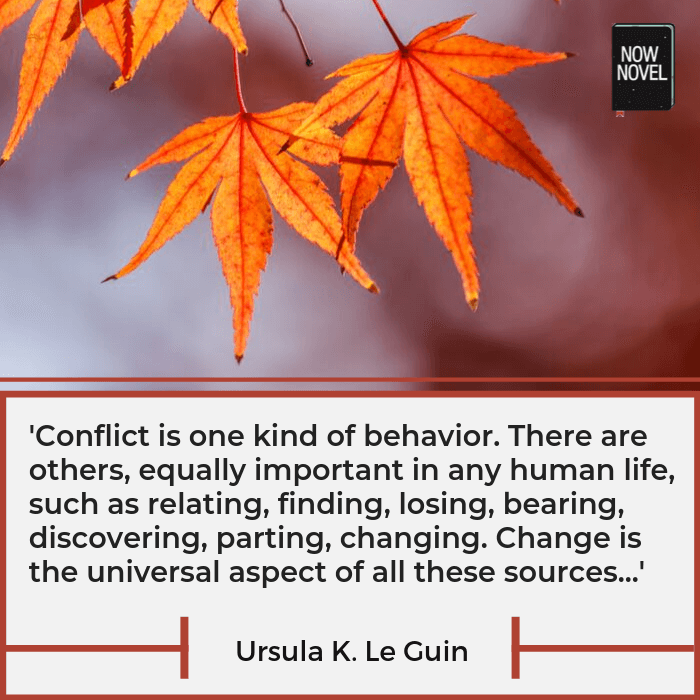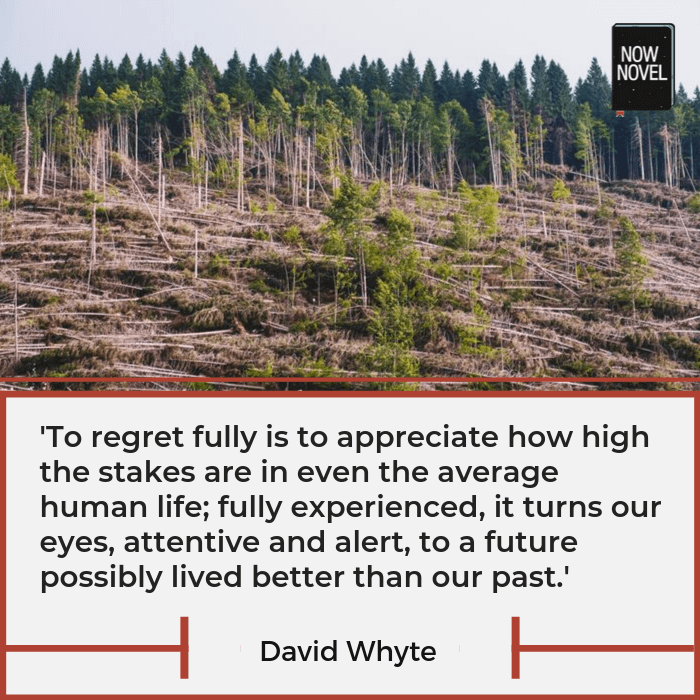What makes a good novel plot? A strong plot has many ingredients. The 5 W’s – who, what, why, where and when – change in interesting ways. Tension builds and ebbs. Read insights from 10 of the top-rated books on Goodreads:
How we chose examples to explore what makes a good novel plot
We took 10 random bestsellers from this list of Goodreads books holding average reader ratings of 4.4 and above. There are at least 25, 000 ratings per book.
What do they say about what makes a novel’s plot work? Well-received books include:
1. Mysteries in significant situations
Every novel is a mystery novel.
That might sound strange. Yet when we pick up a book we haven’t read, everything about it is a mystery. Who the characters are. Where they’re going. What will happen along the way.
Kristin Hannah’s The Nightingale begins in 1939. Vianne Mauriac says goodbye to her husband , Antoine, who’s headed to the Front. The reader likely knows how that specific mystery ended (World War II). Or at least some of its key events and horrors.
The mystery of what makes these specific characters’ lives interesting, within that historical context, lures us in.
In great novels, mysteries swirl around significant, often emotional situations. Plot explores central mysteries’ questions, questions that promise significant change.
In J.K. Rowling’s Harry Potter series, for example, key questions are established early. They aren’t prosaic (such as, ‘What did Harry have for breakfast?’). Rather, they concern key life events: ‘How will Harry’s life change now that he’s away from his mean aunt and uncle?’ Or, ‘After his stifling suburban upbringing, what wonders and challenges await Harry at his new school for wizards?’
How the plot answers these mysteries, and surprises us along the way, is key to reading’s pleasure.
2. Bold changes of fortune
Rowling’s adept use of intriguing story elements that add narrative suspense is a major part of Harry Potter‘s smash success.
On such element is the ‘change of fortune’. In Harry Potter and the Sorcerer’s Stone, the switch from Harry living in a thoroughly non-magical closet under his aunt and uncle’s stairs to attending an exciting school for wizards is full of optimism and wonder, as well as narrative suspense. Greater dangers and downsides come packaged together with the happy change, too.
Memorable changes of fortune feature in non-fiction and novels alike. We’re intrigued by the story of how a stand-up comic from South Africa rose to become the presenter of a beloved American current affairs show (Trevor Noah’s autobiography Born a Crime: Stories from a South African Childhood). We’re intrigued by a disfigured fifth-grader who must brave public school for the first time after being home-schooled (R.J. Palacio’s Wonder).
The way characters’ changes of fortune are often drivers of plot reminds us of Ray Bradbury’s words:
Plot is no more than footprints left in the snow after your characters have run by on their way to incredible destinations.

3. Engrossing conflicts
Conflict is the lifeblood of an interesting story. It may be the global conflict that gives background and context. For example, the World War II backdrop in The Nightingale. Or it may be a character’s private inner strife. Or one of the many smaller oppositions that arise between characters as their lives intertwine and evolve.
In Kathryn Stockett’s The Help, a primary conflict and theme is racism, as the story traces the complex dynamics and responsibilities across divisions of class and race in 1960s Mississippi. Characters hold internal conflicts between class, privilege and responsibility, or between professional, public obligation and their personal, emotional lives.
Lawrence Hill’s The Book of Negroes takes a more unflinching historical look at the pain and injustices of racism in a true story of survival during the height of slavery. Hill’s novel explores how its protagonist Aminata undergoes great suffering and external conflict en route to freedom.
Hill’s conflict is engrossing because it holds contrast, truth and power, showing both human capacity for cruelty and unconquerable endurance.
4. Suspenseful stakes
‘Suspense’ may be a term we associate more with high-suspense genres such as action thrillers and horrors. Yet great plots are suspenseful in every genre. All stories contain narrative suspense – the simple excitement of not knowing what will happen next (and wanting to find out).
Great story plots also often include the suspense of not knowing whether a character’s lot will improve or get worse. ‘Stakes’, in other words.
Stakes arise out of the best and worst case scenarios that swirl around characters and situations. What’s the worst possible outcome of a key battle for each side in a war, for example? Or the worst possible outcome of a mundane a work presentation?
In Angie Thomas’s The Hate U Give, a sixteen-year-old must decide how to act when her unarmed friend is killed by a police officer. What she says (or doesn’t say) could destroy her community – high stakes for sixteen-year-old shoulders.
Other suspenseful stakes include becoming a fugitive after accidentally shooting a sheriff’s brother dead (Lonesome Dove by Larry McMurty), or a man of doubtful guilt facing execution by electric chair unless there is a last-minute reprieve (Stephen King’s The Green Mile).
In each case, worst-case scenarios are dire – characters choices have intriguing, sometimes dramatic stakes attached. These stakes drive events and our emotional investment in how they develop.
[Brainstorm best- and worst-case scenarios for your characters in our easy step-by-step story outlining tool.]
5. Thought-provoking themes
Many of the stories rated highly by thousands of readers on Goodreads tackle big themes. Criminal justice, revolution, war, personal development, racism, good versus evil.
The utility of a theme for crafting a good plot is it that it is both broad/abstract and specific. It sets parameters for what the story could be about, while giving plenty of freedom.
Take for example, the theme of ‘revolution’ (one of the central themes for Terry Pratchett’s Night Watch, in which a policeman must choose his side in a revolution). Given this theme, we could ask:
- What causes revolutions?
- Who has the most to lose in a revolution?
- What’s the greatest thing about a revolution?
- What happens when a revolution fails?
- What lessons has history’s largest revolutions taught us?
From here, we can whittle down to find more specific questions that develop novel plot ideas. For example:
- Who has the most to lose in a revolution, a tyrant or the corrupt policemen who prop him up?
- What does a tyrant do when his power’s slipping and members of his police force start to turn against him?
As an exercise, take a theme (such as ‘good versus evil’) and write five broad questions. Then try to whittle these down into more detailed questions like above.

6. Strong forward momentum
One reason many plot-driven books in genres such as thriller, paranormal horror and fantasy get high ratings is their authors are adept at propelling a story forwards. They know how to keep their readers engaged.
Take Rick Riordan’s The Son of Neptune, for example, from his Heroes of Olympus series. Reader ‘Helen 2.0’ detects a recurring pattern to Riordan’s plots:
There’s a real pattern I’m seeing with plots in Riordan’s books and unfortunately he doesn’t ever seem to stray very far from his one blueprint. It’s always like this: unlikely heroes with secrets from the past go on an impossible quest with a super short time limit; they manage to hit a new mythological threat everywhere they stop, but barely make it past…
Helen 2.0, Goodreads user
This reader is frustrated by what she finds formulaic in Riordan’s plots. Yet Riordan is also clearly sticking to a framework that works for him. The ‘super short time limit’ Riordan gives characters to achieve their goals is one tactic to create urgency and forward momentum, though some readers (like Helen 2.0) may find it obvious.
There are many ways to create this momentum. You may lead a new chapter or section with a hook that promises new revelations. Or end a section at a high-takes moment for a character (whether it is mundane, like missing a bus, or dramatic, like encountering a wild bear).
Good momentum – focusing on making the story move to the next key event – keeps stories lively and engaging, whatever your genre, theme or subject.
Get help developing a better plot with guidance from a seasoned editor.


One reply on “What makes a good novel plot? 6 insights”
Thanks a lot for this insight…
Hopefully, I will start improvising it..